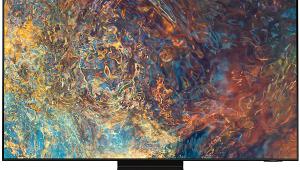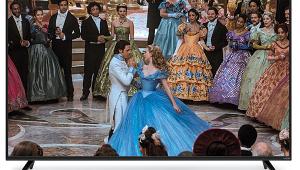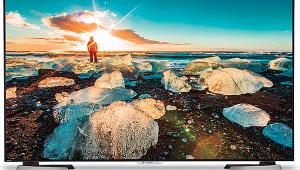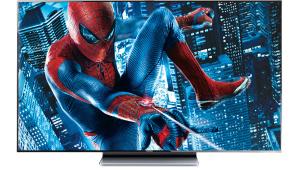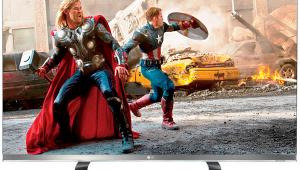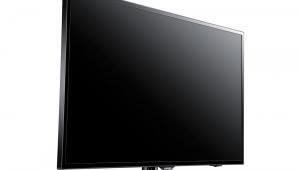Sony BRAVIA KDL-46XBR8 LCD HDTV Page 2
 This and That
This and That
Off-axis performance remains a persistent problem for LCDs, and this Sony is no exception. Its image starts to lose its appeal at roughly 20 degrees off center. By 45 degrees, the picture, while still clearly visible, looks flat and washed out. But I saw no false contouring. And while the Sony’s screen is less mirror-like than many sets on today’s market, it is not completely reflection free.
Sony’s BRAVIA Engine 2PRO video processing includes the latest generation of Sony’s Digital Reality Creation (DRC) technology. As before, this feature offers a wide range of adjustments. But as in its earlier generations, I found that DRC offered no advantages if you want a picture that accurately reflects the source material.
However, DRC did help with the set’s deinterlacing performance. Without it, the Sony’s 480i-to-1080p video processing was generally poor with CineMotion (film mode) set to either Auto1 or Auto2. When I turned DRC from Off to Mode 1, the score improved to fair. That included its satisfactory handling of 3:2 pulldown. For most realworld program material, I found no benefit to DRC and left it off.
The processing was better with 1080i sources. It was fair with DRC off and good with DRC in Mode 1. But while the set dealt with motion properly when deinterlacing 1080i to 1080p, it did not recognize 3:2 pulldown on some of our standard tests. This is a common shortcoming in many of the sets I’ve tested. However, in several hours of viewing real 1080i programming, (with DRC off), I saw no deinterlacing artifacts.
The Nitty Gritty
The KDL-46XBR8’s black level and shadow-detail performance are state of the art. Dark images were truly dark but not murky. On a few rare scenes, I did see a bit of gray haze in one part of a scene or another, or a soft halo around bright highlights on a dark background. Both of these effects appear to be characteristic of local dimming with a finite number of lighting zones, and neither of them were serious distractions.
Samsung’s LN55A950 also offers local dimming. Since I reviewed it in these pages only last month (HT, December 2008), a comparison of these two sets is unavoidable, particularly since both were on hand and I could perform a direct, side-by-side comparison. The differences were…ahh…illuminating.
When the Samsung sees a full-screen black signal, it goes completely black. (All of my black-level observations refer to viewing the sets in a completely darkened room.) However, when the Sony goes black, you can still make out the screen, although it’s very dim. On some program material, a fade-out to black was actually brighter on the Samsung, but this oddity appeared to originate in the source and not the display. The upside here for the Samsung is that it is truly black with a fully dark image. It’s a shade darker than the Sony on the very darkest scenes. The Samsung’s downside is its slightly more visible haloing around those light-on-dark areas. On some dark scenes, the Samsung can also drop to total black-hole black in some areas of the screen while brighter regions remain illuminated. This produces a distracting spotlight effect. The Sony never did this. However, on both sets, the black bars on 2.35:1 sources never completely disappeared. (See the Samsung review in our December 2008 issue for more on that black hole/spotlight effect. It was greatly reduced, but not completely eliminated, by a service-menu change Samsung instituted just before the review went to press.) Despite the above differences in the way they transition from very dark to total black, both the Sony and Samsung produce better black levels and shadow detail than any other LCD sets we’ve yet tested.
The Sony’s color is also superb. Even out of the box, its color tracking (in Warm2) was very good. After calibration, it was as nearly perfect as any set I’ve tested. The set’s color gamut was nearly a perfect match to the HD color standard (but only in the Standard setting of the Color Space control, with Live Color turned off). The only oddity was a slightly cool look to the Sony’s colors (visible only in a few very dark scenes) compared with the Samsung’s somewhat warmer look. It was not obvious from the measurements why this occurred. Fleshtones were appealing and natural on both sets, while reds were a bit less deep and more orange on the Samsung. Greens were nearly identical and looked far more real than on most LCD HDTVs.
The set’s HDMI resolution with high-def material was close to flawless. Even with a relatively small screen at a 10-foot viewing distance, I easily spotted the differences between ultra-detailed transfers like Hidalgo and excellent but very subtly less crisp releases like Indiana Jones and the Kingdom of the Crystal Skull. The Sony also got the best out of good DVD transfers. I popped in a favorite demo DVD that I haven’t played in years, Legends of the Fall (the non-Superbit version). It looked better on the Sony than it ever has. If the quality is there, the KDL-46XBR8 will show it.
Conclusion
If you get the impression that I’m enthusiastic about LCD sets with LED local dimming, you’re right. The three sets I’ve reviewed to date that include this feature, including this Sony, offer the kind of black-level performance I never expected to see from an LCD design.
But blacks alone won’t do it. A premium set must have accurate color, sharp but unexaggerated detail, and good video processing. The Sony slipped a bit on the processing side in specialized tests. Also, its off-axis performance was disappointing, as it is in all LCDs we’ve tested. But viewed from on- or near-center, its color quality and subjective detail are as good as any set I’ve yet tested.
The only downside here is its price; $5,000 is a hefty piece of change for a 46-inch set. (Samsung’s 46-inch local-dimming model, the LN46A950, lists for a less lofty but still pricey $3,500.) Still, for that price, you get bleeding-edge technology and state-of-the-art performance in an LCD. In a couple of years, I predict that LED backlighting and local dimming will make their way into popular-priced sets as well. But that’s then. Now is now. If your budget allows, there are only three lines of flat-panel sets you need to consider today: the Pioneer KUROs, the Samsung 950s, and the Sony XBR8s. They all have undeniable strengths. If your choice is the Sony, you won’t get an argument from me.

